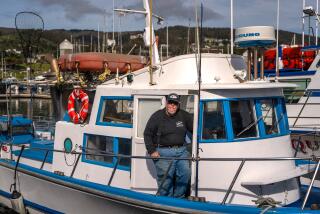Scientists, Historians Writing Real Fish Story
- Share via
BOSTON — A group of historians and scientists intends to learn about life before the Industrial Age by trolling through ancient seafaring records to construct a world history of fishing.
The best records are centuries old, scattered among sources of varying reliability and often buried in the books of bureaucracies.
The project will draw from sources ranging from ancient Danish tithing records to Colonial-era commerce books. It aims to fill in the blanks about the species and the men that have filled plates and coffers for centuries.
Project leaders hope compiling the history will lead to more realistic approaches to regulation, and offer clues about the collapse of a resource once thought inexhaustible.
“It’s exciting to fill in a picture we’ve been trying to fill in for years,” said Andrew Rosenberg, a University of New Hampshire researcher leading the project’s Gulf of Maine study.
The project grew out of talk between Woods Hole, Mass.-based fisheries scientist Tim Smith and Poul Holm, a historian from Southern Denmark University, at a 1999 conference on the history of ocean studies in St. Petersburg, Russia.
It became clear to them that the traditional lack of communication between historians and ecologists wasn’t helping either side. Historians have focused too much on man’s influence on the sea, ignoring nature’s workings, Holm said.
Ecologists, meanwhile, are limited to analyzing trends based on the last 50 years, when they have reliable data about fish stocks.
“We learned a lot quickly, just sitting there,” Smith said.
The 10-year history project is funded by a $1.2-million grant from the Alfred Sloan Foundation and is part of a larger global study called the Census of Marine Life. It includes seven case studies from global regions ranging from southwest Africa to the Gulf of Maine.
Participants include researchers from the universities of New Hampshire, Washington, and Hull, England, and Southern Denmark University, as well as the U.S. government.
Fishermen and their communities will be studied, but the main focus will be the fish themselves, Holm said.
“We’re trying to look at it from nature’s perspective,” he said. “Man has lived off the sea for thousands of years. . . . Just as we need to understand mineral resources, you need to understand the resources of the sea.”
Longtime assumptions about the fishery could be destroyed along the way.
Regulators, for instance, often imagine that a “pristine” ocean world existed before the heavy fishing that began in the 1950s, and they’d like to return the ocean to that state, Smith said. But that pristine state never existed, he said; natural prey-predator cycles and constant weather changes have kept the system in constant flux.
Historical records could provide a picture of the condition of fish stocks before heavy fishing by man, and might result in more realistic recovery goals, Holm said.
Too often, he said, regulators hope to fix what was broken by rebuilding what was never there and ignoring natural cycles.
“This is not a house; this is a huge system,” Holm said.
Filling in hundreds of years of history for a mobile, underwater species won’t be easy. The data just don’t exist for some species in certain areas, and numbers are sparse for others, Smith said.
“The game we’re playing is to choose systems where there’s enough information where you can connect the dots and get a picture,” Smith said.
There are numerous examples of ways a historical record can inform regulators.
In New England, for instance, records such as the English “Blue Books,” which tracked Colonial commerce and detailed shipping logs from numerous ports, offer a window into the history of the all-important cod.
The reports can give a picture of cod before halibut--a major predator--was almost wiped out in the mid-1800s; how much the cod stock grew; where it was caught; and how high cod populations affected fish such as mackerel, which cod eat.
The information can give regulators an idea of appropriate goals for cod recovery and how various population levels might affect other species.
History can also trace the cod to the Baltic Sea, where its reproduction is believed to thrive on a mix of waters from Russian rivers and salt water from the North Sea.
Because the Danish church required a 10% tithe of a fisherman’s catch, historians can use tithing records to measure the stock’s strength over time, and possibly prove a correlation with the ecological record of those water conditions.
Trade records show the Caribbean once teemed with life, as evidenced by the abundance of green turtle shells that were traded in the 1600s. Now it’s a “blue desert,” Holm said.
With more information about what lived there, ecological models can help determine what food was available in the water, and perhaps provide a way to restore some of its former marine life.
UNH maritime historian Jeffrey Bolster, who is also working on the study, said a danger of the research is that it could provide fuel to both sides of the current fisheries debate: one that suggests man is responsible for all of the ocean’s ills, the other that believes man can fix any mess he makes.
He suggests the project can provide a route to a middle way, where the effects of nature and man on the sea are considered in balance.
Aside from any practical application, historians will inevitably understand more about the fishermen and their communities, and learn more about the devastation of fish, he said.
That may be good enough reason for the study, Bolster said. “Sometimes you just want to know why.”
More to Read
Sign up for Essential California
The most important California stories and recommendations in your inbox every morning.
You may occasionally receive promotional content from the Los Angeles Times.











